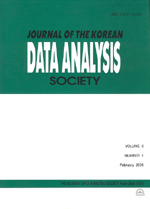P지역 해군 군인의 건강증진행위에 영향을 미치는 요인
The Factors Related to Health Promotion Behavior of the Korean Navy
- 한국자료분석학회
- Journal of The Korean Data Analysis Society (JKDAS)
- Vol.17 No.3
-
2015.061653 - 1666 (14 pages)
- 82

군 조직은 특수하게 조직화된 집단이며, 이들은 규율이 엄격하면서 긴장되고 절제된 생활을 요구받기 때문에 신체적·정신적 질환과 스트레스가 높은 편이다. 그 중에서 특히 해군은 위계질서와 직분별 차이가 명확한 집단이며, 함정근무와 같은 특수성을 가지고 있기 때문에 해군 군인을 대상으로 이들의 건강증진행위를 확인하고 올바르게 정립하는 것이 요구된다. 본 연구는 해군 군인의 건강증진행위에 관련 요인을 파악하기 위하여 시행된 서술적 조사연구로서 해군 군인의 건강증진 프로그램 개발을 위한 기초자료를 마련하고자 한다. 연구 대상자는 P광역시의 10개 부대에 근무하는 해군 군인 148명이었으며, 연구도구는 건강증진행위, 건강신념, 자기효능감을 이용하였다. 해군 군인의 건강증진행위는 4점 만점에 2.83점이었으며, 이에 관련요인은 자기효능감(β=0.385, p<.001), 지각된 민감성(β=0.212, p=.001), 지각된 유익성(β=0.198, p=.015) 및 주관적으로 인식한 건강상태(β=-0.152, p=.024)이었다. 총 회귀식에 대하여 4개의 설명변수들이 가지는 설명력은 39.1%이었다. 따라서 추후에 해군 군인을 위한 건강증진 프로그램의 구성요소로서 본 요인들을 고려한 프로그램 개발이 필요하다.
This study was a descriptive study conducted to find out factors related to health promotion behaviors of naval soldiers. The subjects of the study were 148 naval soldiers working at 10 troops in P metropolitan city. The data collection period was November to December 2013, and self-reported questionnaires was used. Research instruments were health promotion behavior, health belief (perceived benefits, perceived seriousness, perceived sensitiveness and perceived barriers) and self-efficacy. The health promotion behavior of naval personnel was 2.83 out of 4 point. Factors related to the behavior included self-efficacy (β=0.385, p<.001), perceived sensitiveness (β=0.212, p=.001), perceived benefits (β=0.198, p=.015) and subjective health condition (β=-0.152, p=.024). The power of explanation of the four significant variables was 39.1%. The health promotion behavior of Korean naval personnel is relatively high, it should be required to conduct survey for reflecting the characteristics of the subjects, in order to design health promotion program for them. Furthermore, it suggested that four significant variables should be considered when developing the navy’s health promoting program.
1. 서론
2. 연구방법
3. 연구결과
4. 고찰
5. 결론
References
(0)
(0)